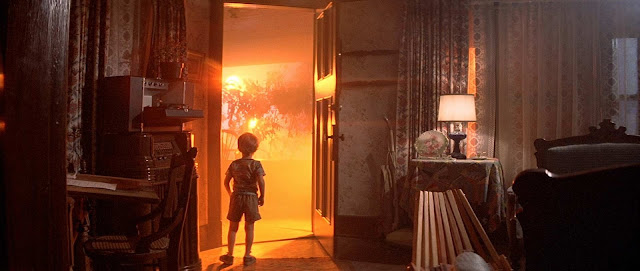Viewing the film this close to Jaws and E.T. was a learning experience. Spielberg's definitive theme, and it's evident in all of his films, is the importance of family. I could go on all day about the wonderful special effects, the now famous yet utterly simple score by John Williams, or even the complete and utter badassery that is getting François Truffaut to head up a committee of eager scientists but the film starts with two families and so then will this article.
Without explaining too much of the plot, Close Encounters is about two families. Both these families have members that end up having a 'close encounter' with an unexplained force. Barry Guiler (a 3 year old) and Roy Neary (Richard Dreyfuss) are the two most affected by them. Barry is abducted by aliens early in the story while Roy becomes obsessed with a number of images that have seemingly been burned into his brain. These images drive him throughout the film and wind up taking him and Barry's mother Jillian (Melinda Dillon) to Devil's Tower in Wyoming. It's here that humankind makes official contact with these aliens. In a quick summation there's nothing overly jaw dropping about this film. We've seen this story before (often as a result of parody and emulation of this film) but Spielberg takes a fairly pat science fiction story and turns it into a classic with the same methodology he used on Jaws. The early scenes show two families simply living their lives. I don't know what Spielberg does but he has a way with child actors that I've never seen with any other filmmaker (save maybe J.J. Abrams in Super 8). He manages to capture children as they are rather than children trying to act like children. Watching Barry's face light up with excitement or confusion as he encounters otherworldly beings is something we've all seen a thousand times when interacting with little cousins or siblings who discover something new. Spielberg's family dynamics are the same way. They ring true in a way that forces the viewer to drop what they're doing and get completely sucked into the film. I can't imagine a film like this being made today with the same patience. The first time we meet Roy Neary he's using model trains to try and help his son with his math homework. They spend the next ten minutes arguing about the family's plans for the evening. There's no hurry to get to the titular event. For all we know it may never come. But with how well these household situations are handled I really didn't mind waiting. Spielberg does this same thing in Jaws.
The film's final act is a long one. The "contact" sequence is one of the most famous in American film history but what's interesting is that out of context it's completely underwhelming. Close Encounters is sewn together in such a great way that even though the ending might appear slow or anticlimactic, to the audience it's completely wonderful. Many of the films questions are answered and the dazzling natures of the colors and sounds used in the alien ship's design is nothing short of awe inspiring.
And it's this ending that sets Close Encounters apart from so many other science fiction efforts. There's no battle. There's no threat. Instead there is hope. A hope for humanity I've never seen in other films. There's a wonderful quote from a film critic named Charlene Engel that says that the film "suggests that humankind has reached the point where it is ready to enter the community of the cosmos". Doesn't that just reek of Carl Sagan? And rightly so. It's a beautiful notion. Sure, plenty of sci-fi films present aliens as villains but its even more easy to believe that we'd be the aggressors were we to ever actually encounter an otherworldly force. And the idea that they allow a human chosen team aboard their ship only enhances the idea of an open dialogue between worlds. It's a wonderful ending to a great film and I give Spielberg a lot of credit for making it.
Next up:





No comments:
Post a Comment